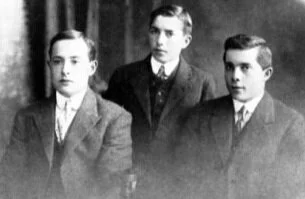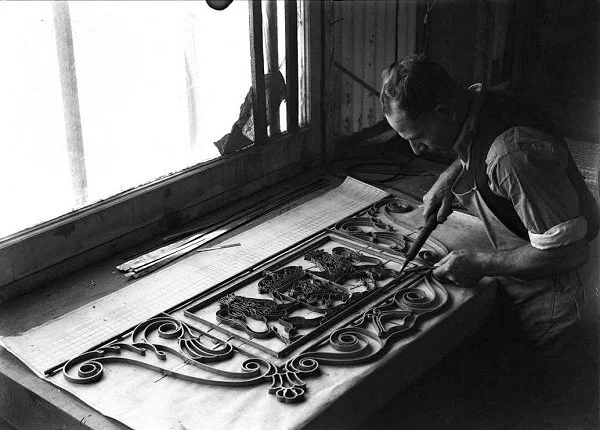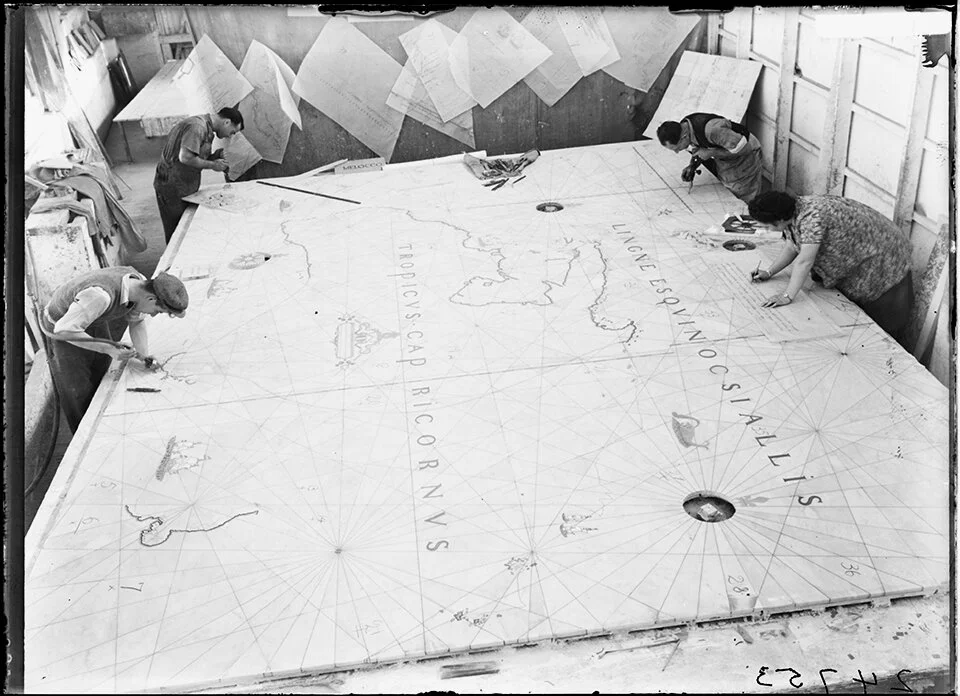Melocco’s Lewisham employees, November 1938.
It all started when…
The Melocco brothers, Tony, Galli, and Peter, in 1912.
Peter Melocco, aged 26, arrived in Sydney in1908. Originally from the village of Toppo, in the province of Udine, Northern Italy, Peter's training as a mosaic artist and marble worker began at the Coopers Union Trade College in New York.
Peter rented a shop at 16 Regent St, Redfern, NSW in October that same year and this is where the operations of Melocco commenced.
One of Peter's first achievements was convincing Cardinal Moran to consider his design for the altar floor of the Chapel of the Irish Saints in the eastern wing of St Mary's Cathedral. Peter impressed Cardinal Moran with his enthusiasm and designs and whilst he was initially hesitant because of Peter’s age he proceeded.
It took Peter just over two years to complete this floor of over 600m sq. The job left Peter with a profit of 200 pounds which he used to bring his brothers Anthony and Galliano to Australia in June 1910. Melocco then became Melocco Brothers. Galliano was a 12-year-old schoolboy and Anthony a tradesman trained as a mosaic worker in Paris. Anthony immediately joined his brother Peter in the business while Galliano studied as a Mechanical Engineer. From school, Galliano went to sea as a merchant seaman and did not join the family until 1920.
In 1913 Melocco Bros. moved to larger premises in Parramatta Road, opposite the University Grounds. The Melocco’s stayed here until 1919 when they bought the property at No1 Booth St, Annandale where the company stayed until the 1970s.
The Melocco Bros. were the first tradesmen to practice the Mosaic Craft in New South Wales. The first five years of the company's existence were dominated by work in bathrooms around Sydney's eastern suburbs. The Melocco’s introduced Terrazzo to Australia, which immediately became a very popular bathroom material and also carried out some of the finest decorative plasterwork in many private homes, theatres, and public buildings. In the 1920s there were between 100 - 200 people working for Melocco.
The depression of the 1930s saw Galliano began to play an active part in the company. He built up the concrete and construction side of the company and it was through concrete placing and road work that Melocco were able to keep their employees busy during these tough times.
Melocco Bros craftsman making the brass filigree fretwork for a coat of arms for Mitchell Library vestibule floor mosaic 1940. Image: State Library of NSW
During this time, Melocco Bros. was the first private company to use mechanical cement mixers. It was also during the 30's that "composite stone" was introduced – a combination of cement, dye, marble & granite chips, made up into pre-cast panels. Melocco Bros. used these panels as facing for many Sydney buildings.
The amount of Terrazzo work fell away until the '50s and concrete work really took over. During this period Anthony became ill and left the firm, he later died in 1948.
The Terrazzo inlay floor in The Crypt at St Mary's Cathedral took Peter from 1945 to 1958. The design was in the shape of a Celtic cross done in consultation with the late Rev. Dr. W. Leonard. This was Peter’s last great work and many considered it his greatest achievement before his passing in 1961. It is a work of international standard and really should be visited whilst in Sydney.
During the late 50’s, Melocco expanded into Victoria purchasing Charles Heath and Sons (stonemasons in South Melbourne) and Demarco Brothers (Terrazzo, Granolithic, and Concrete Placing also in South Melbourne). These operations were amalgamated and moved to a large site at Springvale junction in 1963.
At this time Melocco had developed the largest fleet of agitator trucks in Australia trading under the name of Certified Concrete – and hence it was no surprise that the company was purchased by Blue Metal Industries (BMI) in 1962 to augment their large aggregate & sand business.
In 1982 Boral Ltd acquired BMI Ltd and during the '80s Melocco Pty Ltd continued to prosper through major re-equipment and the purchase of Granites of Australia in Canberra.
The management of Melocco Stone purchased the operations from Boral in 2000 & re-established operations in Dandenong South, Victoria, whilst sourcing its Australian dimension stone from multiple quarries across the country. The company has continued to prosper with a focus on the continued development of the Australian stone industry, new stone resources, and new equipment.
In 2024, Sam the Paving Man strategically acquired Melocco, bringing over a century of heritage stone expertise into its operations. The move consolidates supply, enhances production capacity, and strengthens technical capability, while relocating Melocco’s processing premises to Hindmarsh, Adelaide positions the business closer to the quarry, reducing transport distances, emissions, and costs. This acquisition not only preserves Melocco’s legacy of craftsmanship but also supports Sam the Paving Man’s commitment to sustainable, locally processed Australian stone and expands its ability to deliver high-quality, architecturally significant projects.
Floor in the crypt of St Mary's Cathedral. Image: Mike Stacey
Entrance to Dymock's Book Arcade; Melocco Bros terrazzo paving, 1938, Sydney. Image: State Library of NSW
Melocco Bros working on the Tasman Map mosaic, 1940. Image: State Archives & Records of NSW
One of Melocco’s original Blocksaws, circa1972.
Sydney Opera House Forecourt, 2015.








